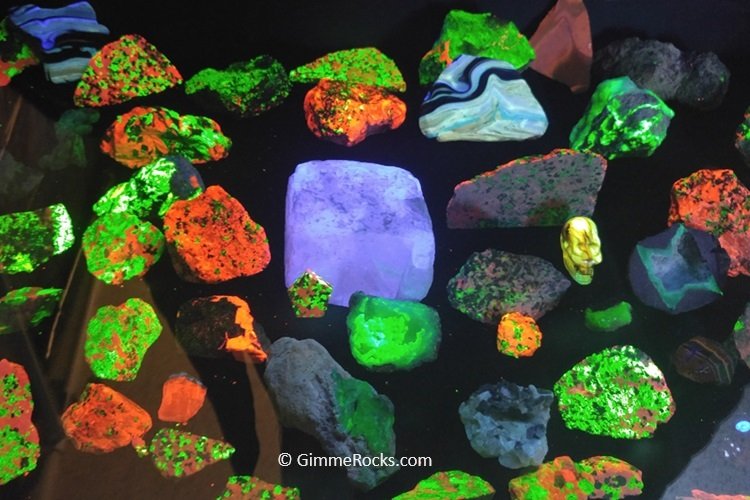Fluorescent minerals, those seemingly ordinary stones that transform into vibrant neon artworks under ultraviolet light, represent a fascinating intersection of geology and physics.
This article delves into the science behind fluorescence, the varying effects of UV light on minerals, and how these glowing rocks are not just marvels of nature but also subjects of scientific study and passionate collection.
Understanding Fluorescence: A Light Show Hidden in Rocks
Fluorescence is akin to a hidden superpower of certain minerals. These minerals absorb invisible ultraviolet (UV) light (also known as "black light") and emit it as visible, radiant colors.
Friedrich Mohs first noted this phenomenon in 1824 in fluorite crystals, and it is named "fluorescence" after its initial discovery.
Mohs, renowned for his Mohs scale of hardness, observed fluorite's astonishing color change under UV light—a finding that opened a new window into mineralogical studies.
UV lights, essential tools for viewing fluorescence, emit light at various wavelengths: long, mid, and short waves. Interestingly, some minerals react distinctly to these different wavelengths, showcasing fluorescence in one, some, all, or neither wavelengths.
This variability underscores the uniqueness of each fluorescent specimen, with even seemingly identical minerals from the same location displaying differences in their fluorescent properties.
However, it's important to note that a mineral's fluorescence is not the most reliable key to identifying one mineral from another.
Mineral Identification Guide - Basic Home Tests
Mineral key identification, relying on the examination of physical properties, serves as a valuable process to ascertain the identity of a mineral. These properties act as guides, leading observers through a series of choices that help narrow down possibilities and ultimately identify the mineral.
Behind the Glow: Atomic Excitement
But why do some minerals put on this mesmerizing light show? The answer lies in the excitation of atoms. When exposed to UV light, certain atoms within the mineral absorb energy and move into a higher-energy state.
This excited state is temporary, and as atoms return to their ground state, they release energy in the form of fluorescent light. Minerals containing trace elements have the highest propensity for fluorescence. Atoms in those rocks are more likely to become excited because of instability caused by various outside inclusions.
Moreover, some minerals are not only fluoresce but also phosphoresce. These rocks continue to emit light even after the UV source is removed. This extended glow, or afterglow, adds another layer of complexity and beauty to the world of fluorescent minerals.
A Museum of Nighttime Rainbows: The Franklin Mineral Museum
The Franklin Mineral Museum in New Jersey is a must-visit destination to witness the spectacular display of fluorescent minerals. Originally an active mine from 1898 until the mid-1950s, it has been transformed into a captivating museum with many unique features.
At the museum, visitors can explore an extensive collection of fluorescent minerals that illuminate under UV light, revealing a dazzling palette of colors. The display spans an impressive 32 feet and is recognized as the world's largest collection of fluorescent rocks!
Additionally, the museum offers an exciting experience with a life-size mine replica where visitors can collect unique minerals themselves. This interactive feature allows guests to immerse themselves in the world of mineralogy and experience the thrill of discovery firsthand.

The Thrill of the Hunt: Collecting Fluorescent Minerals
Collecting fluorescent minerals is akin to a treasure-hunting adventure. Often, luminous pieces are mixed with regular rocks and look the same during the day. However, exploring these areas with a portable UV light during natural or artificial darkness will reveal vivid neon colors.
Fluorescent Sodalite
The shores of Lake Superior in Michigan are renowned for fluorescent sodalite, a mineral that emits a bright yellow and orange glow when exposed to UV light. However, you can find many rocks resembling fluorescent sodalite without desired properties along the shores.
The best way to differentiate fluorescent sodalite from imposters is to use high-quality UV light during low-light conditions or at night. This method ensures that the mineral's unique vibrant glow is clearly visible, distinguishing it from other rocks.
